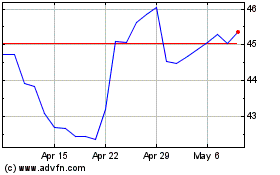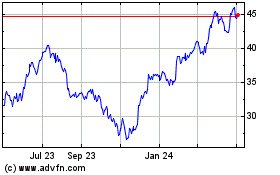GM's Profit More Than Doubles--Update
July 21 2016 - 9:52AM
Dow Jones News
By Gautham Nagesh
General Motors Co., bolstered by strong truck and SUV demand in
its core market, posted a 157% increase in net profit in the second
quarter, leading the Detroit auto giant to lift annual guidance
even amid concerns about financial impact of the U.K.'s decision to
exit the European Union.
The auto maker under Chief Executive Mary Barra has spent much
of 2016 retooling for the future, spending more than $1 billion to
invest in ride-sharing firm Lyft Inc. and to purchase
autonomous-vehicle developer Cruise Automation Inc. Ms. Barra, who
spent her initial months at the auto maker mired in a
vehicle-safety crisis, has been working to convince Wall Street
that GM can thrive in a cyclical car industry that analysts
increasingly believe has peaked after years of growth.
GM's underlying performance is showing no signs of slowing down,
with the company notching more than a dozen postbankruptcy
financial records in the second quarter. The auto maker filed for
bankruptcy protection in 2009, and has spent the following seven
years focusing on growing operating margins and the company's
return on invested capital to a point that rivals the industry's
top performers.
GM on Thursday said net income attributable to common
shareholders grew to $2.9 billion in the second quarter, up from
$1.1 billion in the same period a year ago. The company said
operating profit equaled $1.86 per share, soundly beating Wall
Street expectations of $1.49 a share.
Revenue rose 11% to $42.4 billion versus $38.2 billion one year
ago. GM shares were up 4.6% to $32.95 in premarket trading,
slightly below the $33 price the company traded at when it went
public in 2010.
GM has benefited from the continuing shift in the U.S. from
passenger cars to trucks and SUVs, steady sales increases in China
and improved conditions in Western Europe. Its operating margins of
9.3% globally and 12.1% in North America represent records, the
company said, and come despite relatively flat sales and a decline
in market share in the U.S.
GM posted a roughly $100 million profit in European operations,
its first quarterly profit in the region since 2011. Its 9.5%
operating margin in China was slightly lower than the same period
in 2015, but the company's performance in the world's largest
market is stable. GM's volumes in China are significantly larger
than its U.S. sales, but GM North America's $3.6 billion operating
profit dwarfs the $500 million in equity income the company earned
in China during the second quarter.
The results lend credibility to Ms. Barra's strategy of slimming
down the company to focus on profitability over gaining market
share. In the U.S., the company has been backing away from
lower-margin sales to rental-car companies and has resisted adding
production capacity to conserve costs. It is gradually building out
its brand presence in China by adding Cadillac luxury cars and more
SUVs for local brands sold there.
GM Chief Financial Officer Chuck Stevens said GM expects its
U.S. market share to improve in the second half of the year as it
finishes its pullback on daily rental car sales, and new models
like the Chevrolet Cruze and Malibu sedans hit the market in force.
Cadillac is also launching new products in the U.S., and GMC will
be selling a redesigned family SUV.
Mr. Stevens, however, said uncertainty created by the U.K.'s
referendum to exit from the EU has negatively impacted the British
pound and that could hurt production and sales activities
there.
Mr. Stevens said it was too early to determine exactly what the
impact of Brexit would be, but said if the pound stays weak it
could cost GM up to $400 million and jeopardize the company's goal
of turning profitable in Europe this year. GM Europe was profitable
in Europe in the second quarter for the first time since 2011.
"Clearly the Brexit vote has created a potentially significant
headwind, " Mr. Stevens told reporters.
GM raised its full-year outlook for earnings by a quarter per
share to a range of $5.50 to $6.00.
Mr. Stevens also revealed that GM's acquisition of the
self-driving car startup Cruise Automation, which closed in May,
cost the auto maker $581 million at closing, half in cash and half
in stock.
That figure doesn't include money that could be spent on
retaining employees and for bonuses if key performance goals are
achieved. Mr. Stevens said such payouts would be considered ongoing
compensation. People familiar with the terms of the deal said the
total payout could exceed $1 billion.
Write to Gautham Nagesh at gautham.nagesh@wsj.com
(END) Dow Jones Newswires
July 21, 2016 09:37 ET (13:37 GMT)
Copyright (c) 2016 Dow Jones & Company, Inc.
General Motors (NYSE:GM)
Historical Stock Chart
From Aug 2024 to Sep 2024

General Motors (NYSE:GM)
Historical Stock Chart
From Sep 2023 to Sep 2024
